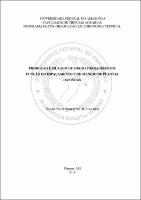| ???jsp.display-item.social.title??? |


|
Please use this identifier to cite or link to this item:
https://tede.ufam.edu.br/handle/tede/6373| ???metadata.dc.type???: | Tese |
| Title: | Produção e silagem de sorgo forrageiro em função do espaçamento e do manejo de plantas daninhas |
| ???metadata.dc.creator???: | Castro, Francisco Martins de  |
| ???metadata.dc.contributor.advisor1???: | Silva, José Ferreira da |
| First advisor-co: | Dias, Fábio Jacobs |
| ???metadata.dc.contributor.referee1???: | Silva, José Ferreira da |
| ???metadata.dc.contributor.referee2???: | Dias, Fábio Jacobs |
| ???metadata.dc.contributor.referee3???: | Albertino, Sônia Maria Figueiredo |
| ???metadata.dc.contributor.referee4???: | Schimpl, Flávia Camila |
| ???metadata.dc.contributor.referee5???: | Perin, Rogério |
| ???metadata.dc.description.resumo???: | O sorgo forrageiro é uma cultura com elevada capacidade de rendimentos de forragem por hectare, com larga escala para produção de silagem. É cultivado em diversas regiões do Brasil e se adapta facilmente aos diferentes sistemas de cultivo. Dessa forma, objetivou-se com essa pesquisa analisar o crescimento, produção e a composição química da silagem do sorgo forrageiro em função de diferentes métodos de controle de plantas daninhas e espaçamentos. O delineamento experimental foi em blocos casualizados, em parcelas subdivididas com quatro repetições, sendo os tratamentos da parcela os espaçamentos (40, 50, 60, 70, 80 cm entre linhas) e na subparcela os métodos de controle de plantas daninhas: herbicida; capina manual com enxada; e sem capina. A silagem foi confeccionada em mini silos. Foram estimados a matéria seca da parte aérea (MSPA), índice de área foliar (IAF), taxa de crescimento relativo (TCR), taxa de crescimento da cultura (TCC), taxa assimilatória líquida (TAL). Para análises da produtividade foram avaliadas a matéria seca das plantas daninhas, matéria seca do sorgo, matéria seca dos componentes morfológicos (folha, colmo e panícula) e a área foliar do sorgo na ensilagem. O controle das plantas daninhas, aliado aos maiores espaçamentos proporcionou maior acúmulo de MSPA, porém os menores espaçamentos produziram maiores IAF, DAF, TCC. Os melhores índices produtivos foram encontrados quando realizado o controle das plantas daninhas com herbicida aliado ao espaçamento 50 cm entre linhas, proporcionando maior produção de matéria seca do sorgo em t ha-1 e juntamente com o espaçamento de 40 cm as menores produções de matéria seca das plantas daninhas em t ha-1. Além das melhores proporções dos componentes morfológicos em comparação ao tratamento com capina que teve maior proporção de colmo, menos folhas e panícula. Na composição química o controle de plantas daninhas com herbicida aliado aos menores espaçamentos (40, 50, 60 cm) mostrou-se mais eficientes favorecendo a qualidade da silagem, com teores superiores de proteína bruta (PB), matéria mineral (MM) e inferiores da fibra em detergente neutro (FDN). A redução dos espaçamentos e o controle químico das plantas daninhas proporcionaram melhores índices de crescimento, maior produtividade e melhor composição química da silagem para o sorgo forrageiro, sendo indispensável o controle das plantas daninhas nas condições ambientais da Amazônia Central. |
| Abstract: | Forage sorghum is a crop with high forage yield per hectare, with large scale for silage production. It is cultivated in several regions of Brazil and easily adapts to different cropping systems. Thus, the objective of this research was to analyze the growth, production and chemical composition of forage sorghum silage as a function of different weed control and spacing between raw. The experimental design was randomized blocks, in subdivided plots with four replications, the treatments of the plot being the spacings (40, 50, 60, 70, 80 cm between rows) and in the subplot the weed control methods: herbicide; manual hoeing with hoe and without weeding. The silage was made in mini silos. The aerial part dry matter (DMAP), leaf area index (LAI), relative growth rate (RGR), crop growth rate (CGR) net assimilation rate (NAR). The dry matter of the weeds, dry matter of the sorghum, dry matter of the morphological components (leaf, stem and panicle) and sorghum leaf area in silage were evaluated for productivity analysis. Weed control, together with the larger spacings, provided greater accumulation of DMAP, but smaller spacings produced higher LAI, DLA, and GRC. The best productive indexes were found when weed control with herbicide allied to the spacing 50 cm between rows, providing higher dry matter yield of the sorghum in t haˉ¹ and, together with the spacing of 40 cm, the lowest yields of dry matter of weeds in t haˉ¹. Besides the better proportions of the morphological components compared to the treatment with weed that had a higher proportion of stem, less leaves and panicle. In the chemical composition, the weed control with herbicide, together with the smaller spacings (40, 50, 60 cm), were shown to be more efficient favoring silage quality, with higher levels of crude protein (CP), mineral matter (MM) and lower neutral detergent fiber (NDF). The reduction of the spacings and the chemical control of weeds provided better growth rates, higher productivity and better chemical composition of the silage for the forage sorghum, being indispensable the weed control in the environmental conditions of Central Amazonia. |
| Keywords: | Capina Conservação de alimentos Hoeing Densidade de plantas Herbicida Food conservation Plant density Herbicide |
| ???metadata.dc.subject.cnpq???: | CIÊNCIAS AGRÁRIAS: AGRONOMIA |
| Language: | por |
| ???metadata.dc.publisher.country???: | Brasil |
| Publisher: | Universidade Federal do Amazonas |
| ???metadata.dc.publisher.initials???: | UFAM |
| ???metadata.dc.publisher.department???: | Faculdade de Ciências Agrárias |
| ???metadata.dc.publisher.program???: | Programa de Pós-graduação em Agronomia Tropical |
| Citation: | CASTRO, Francisco Martins de. Produção e silagem de sorgo forrageiro em função do espaçamento e do manejo de plantas daninhas. 2018. 124 f. Tese (Doutorado em Agronomia Tropical) - Universidade Federal do Amazonas, Manaus, 2018. |
| ???metadata.dc.rights???: | Acesso Aberto |
| ???metadata.dc.rights.uri???: | http://creativecommons.org/licenses/by-nc-nd/4.0/ |
| URI: | https://tede.ufam.edu.br/handle/tede/6373 |
| Issue Date: | 28-Mar-2018 |
| Appears in Collections: | Doutorado em Agronomia Tropical |
Files in This Item:
| File | Description | Size | Format | |
|---|---|---|---|---|
| Tese_Francisco M. Castro.pdf | 2.67 MB | Adobe PDF |  Download/Open Preview |
This item is licensed under a Creative Commons License





